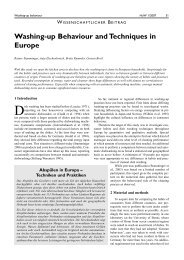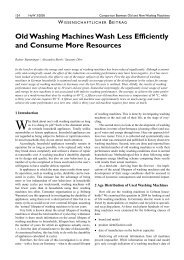Development of a novel mechatronic system for mechanical weed ...
Development of a novel mechatronic system for mechanical weed ...
Development of a novel mechatronic system for mechanical weed ...
You also want an ePaper? Increase the reach of your titles
YUMPU automatically turns print PDFs into web optimized ePapers that Google loves.
2.1.2 Active tools <strong>for</strong> intra-row <strong>weed</strong> control<br />
State <strong>of</strong> the art<br />
There are no commercially available powered intra-row <strong>weed</strong>ers, but several<br />
prototypes have been developed over the past 15 years. One was developed in<br />
the late 1990’s at Halmstadt University, Sweden. It is an autonomous robot with<br />
a vision-guided plant recognition <strong>system</strong> developed <strong>for</strong> sugar beet plants.<br />
Standing on four wheels, it is driven by two DC-servo motors on the two rear<br />
wheels and uses a rotating hoeing tool (1) which is lowered to <strong>weed</strong> and raised<br />
to pass over plant by use <strong>of</strong> hydraulic cylinder (see Figure 2.2). The vision<br />
<strong>system</strong> uses up to 19 plant characteristics to differentiate plants and <strong>weed</strong>s.<br />
The concept and a prototype <strong>of</strong> this <strong>system</strong> are shown in Figure 2.2.<br />
Figure 2.2 Concept and prototype <strong>of</strong> the intra-row hoeing developed<br />
at Halmstadt University (1 - <strong>weed</strong>ing tool, 2 - colour<br />
camera <strong>for</strong> plant identification, 3 - computer) (Åstrand B.<br />
2002)<br />
In Denmark, a hoeing <strong>system</strong> based on geo-referenced plant maps has been<br />
developed using the Osnabrück hoe (Griepentrog 2005). During the planting a<br />
location <strong>of</strong> every seed is recorded and this data are used <strong>for</strong> development <strong>of</strong> a<br />
geo-referenced seed map. The same map is a background <strong>for</strong> the control <strong>of</strong> the<br />
hoeing tool during the <strong>weed</strong>ing process. This hoeing <strong>system</strong> uses two RTK-<br />
GPS receivers and a tilt sensor <strong>for</strong> exact orientation during the <strong>weed</strong>ing.<br />
The Osnabrück hoe is a cycloid hoe consisting <strong>of</strong> a rotating cylinder on a<br />
vertical axis. Eight tines extend down vertically from the cylinder and are used<br />
to work the ground (see Figure 2.3). While the tractor moves <strong>for</strong>ward, the<br />
21





